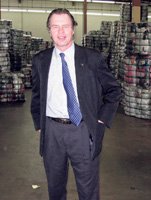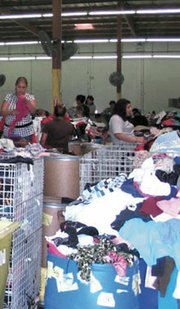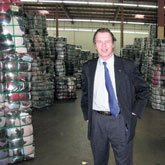Taking Textiles Out of Landfills
Soex’s textile-recycling process comes to L.A.
The apparel and textile industries, while creating clothes for fashion-hungry consumers, are also among the largest creators of waste. Remnant fabrics and used clothing in Los Angeles account for up to 10 percent of trash clogging up landfills, according to city estimates. Several companies are saying enough is enough and have launched aggressive recycling programs.
Manufacturers such as Nike Inc. and Patagonia operate recycling programs for their own products. Now, another company, Soex Group, based in Wolfen, Germany, has set its sights on the entire industry.
The company recently opened a plant in Vernon, Calif., and a subsidiary, Soex West USA LLC, which is part of a pilot program to determine if the U.S. market is viable for its professional recycling business. So far, it looks like a go, said Michael Koelln, director of the U.S. operations.
The criteria are already there. Despite efforts by charitable organizations such as the Red Cross, Salvation Army and Goodwill, a large amount of clothing ends up in landfills. And even though the manufacturing base in California has contracted in recent years, the remaining apparel and textile producers still account for a good percentage of textile waste.
Putting a pair of old jeans back into use rather than in the dump can save valuable resources. One company estimated that it takes as much as 8,000 liters of water to grow the cotton used for just one pair of jeans.
Soex is one of the few large-scale professional recycling companies in business. While its aim is to make a profit, its primary objective is also to clean up the planet. The company’s mission statement is simple: zero waste.
Soex collects used clothing from charities and other sources and then distributes reusable clothing to Third World countries. It actually buys clothing that organizations like Goodwill and Salvation Army cannot sell for whatever reason. It sells the reusable clothing to merchants in Third World countries. Soex also accepts donations.
“It’s basically a penny business, said Koelln. “When it reaches the consumer in a Third World country, they can buy it for a dollar or so.”
Clothing that is damaged or otherwise unusable is recycled through high-tech machinery that transforms the fabric into products such as automobile insulation, blankets and underlay for carpets. The process is done without chemicals, water or toxins.
Soex developed the machines used to extract fibers from cut material. The machines, which have been modified several times by the company, use cutters and blowers to extract the fibers, with different machines used for specific fabrics. In the case of finished garments with hardware-like buttons and zippers, the process separates the fibers from the hardware, which fall through a filter.
Soex’s plant in Germany also operates on solar power. The plant in Germany handles more than 300 tons of fabric per day. The company’s employees are trained to sort clothing and materials using more than 400 criteria.
Despite its small profit margin, Soex has grown to operate a business with sales in the triple-digit millions, Koelln said. It takes $60 million to $80 million to build a new plant. Not many companies are equipped to make that investment or take the risk, Koelln noted. Over the past 25 years, Soex has built up a network of subsidiaries in 14 countries and employs more than 2,500 worldwide. Its infrastructure has enabled it to export used clothing around the world.
Setting down roots
In Los Angeles, Koelln’s objective is to find a permanent home for a Soex plant. It currently operates in a 150,000-square-foot facility in Vernon, where sorting of incoming clothing takes place. It recycles the used product at a facility in Fresno, Calif. It recently secured another 150,000 square feet of space adjacent to its Vernon plant but eventually needs about 750,000 square feet for a permanent facility. Getting that kind of real estate in a very dense real estate market may be difficult, but Koelln hopes the city of Los Angeles or another entity could step in and help. A new facility can create as many as 1,000 new jobs, Koelln said.
In the meantime, Soex is working with the city to recover much of the clothing and textile waste that ends up in city-affiliated dumps. Mayor Antonio Villaraigosa has initiated a program that aims to recycle 70 percent of city waste by 2015. An estimated 10 percent or 112,000 tons per year of the waste is clothing.
“The mayor is doing the right thing,” Koelln said.
The mayor’s plan is part of Los Angeles’ “Greenest and Cleanest Big City” program, which includes refuse recycling, a 1 million-tree-planting program, water conservation and energy-efficient construction. According to the mayor’s Web site, (www.lacity.org/MAYOR/villaraigosaplan), the city collects refuse, recyclables and yard waste from more than 750,000 households at an average of 6,600 tons per day. Los Angeles has a 62 percent solid-waste diversion rate, according to the Web site. The solid-waste conversion rate is the amount of solid waste that is diverted from landfills through recycling or reduction efforts. The mayor’s initiative calls for diverting up to 70 percent of the city’s garbage from landfills by 2015.
According to Koelln, Soex has proposed a program to the city of Los Angeles to enlist consumers in its recycling efforts. If approved, Los Angeles residents would be provided with large clear bags for waste clothing and textiles. The bags would then be deposited in city bins and Soex would collect them at the refuse-processing depot.
Soex also is targeting apparel manufacturers and importers. Some companies have old apparel stock that is second quality or consists of outdated styles. Others toss out tons of textile swatches a year that can otherwise be recycled, and excess materials left behind during cutting can also be used. All of it can be recycled, Koelln said.
“It does not have to go in the trash,” he said. “We have to educate them.”
Koelln pointed out that his company’s recycling process can also solve manufacturers’ problems such as what to do with written-off inventory.
Soex’s director, Hagop Ohanian, emphasized that the company is in business only because there is too much waste in the world.
“The challenge is to eliminate the waste before it gets to us,” he said.
Recycle, renew
Aside from Soex, companies such as Nike take old shoes and grind up the soles to make into new products. Patagonia gathers used fleece products from its customers and ships them off to Japan, where they are recycled into new fleece material.
Spartanburg, S.C.–based Martex Fiber Southern Corp. markets recycled yarns that can be used for sweaters, T-shirts, hats, socks and other woven products.
The company gets remnant fabric from apparel manufacturers and mixes it with a blend of 25 percent to 50 percent of staple fiber to create a product that is priced substantially lower than dyed cotton and comes in about 50 colors.
The product is marketed under its Eco2Cotton division and is used in yarns, fabrics and fiber for apparel, home furnishings and non-wovens.
“It’s being well-received in the eco market,” said Stefanie Zeldin, director of corporate marketing. “A lot of our customers are utilizing it to tell their own eco stories.” Zeldin said apparel-industry customers like the yarns because of the colors that can be achieved with recycled materials. “When you take cotton from a T-shirt that has already been dyed and washed, you get something that is very similar to blue cotton, so you get some beautiful heathers.”
The company has employed some type of recycling since its launch in 1970 and has been proactive in educating apparel manufacturers and others about reducing waste in their operations.

























